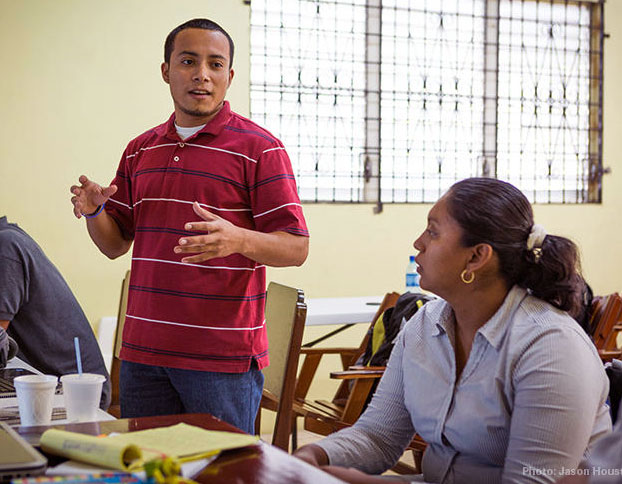STEP 5
Brainstorm Climate-Resilience Actions
In this step:
- Revisit the goals from Step 2
- Brainstorm actions to enhance climate resilience in the fishery

Fishery meeting in Belize. Photo: Jason Houston/EDF
Background
The previous steps were designed to help define the fishery system, set long-term goals, identify climate impacts, and assess climate-resilience attributes. In Step 5, this information is synthesized and used to help brainstorm potential actions to increase climate resilience.
The first step is to revisit the goals articulated in Step 2. Now, with a consideration of the climate impacts already occurring or expected to occur in the fishery system, are there any goals that should be modified or added? Goals can be revisited at any time to ensure that they are S.M.A.R.T. (specific, measurable, assignable, realistic and time-related).
Actions for enhancing climate resilience fall into two general categories: (1) actions to address specific climate impacts (identified in Step 3), and (2) actions to increase climate resilience more broadly by building important ecological, socio-economic, or governance attributes into the system. In general, potential actions should help achieve the goals set for the fishery while effectively addressing climate impacts or enhancing resilience attributes of the system. Some questions to consider include:
- Which actions may be most effective at addressing the most pressing climate impacts facing the fishery?
- Which resilience attributes are most needed, and which actions could enhance them?
- Are there actions that would address climate impacts and provide ancillary benefits to the fishery or community?
In this step, think openly about a diverse range of possible actions to enhance climate resilience of the fishery system; this list will be narrowed in Step 6.
See below for examples of potential actions to address various climate impacts and enhance various climate-resilience attributes, and read the case studies to learn about actions taken in fisheries around the world.
Example Actions that Address Impacts

IMPACT:
Decreased catch due to stocks changing location
ACTION:
Increase flexible access rights to fisheries resources

IMPACT:
Loss of fishing-related assets (e.g., vessels and shoreside infrastructure) in storms
ACTION:
Protect harbors and landing sites

IMPACT:
Loss of household monetary wealth and assets
ACTION:
Facilitate access to alternative livelihood opportunities
Example Actions that Build Specific Resilience Attributes
RESILIENCE ATTRIBUTE:
Habitat diversity and quality (Ecological)
ACTION:
Protect habitat quality by mitigating local chronic stressors impacting the area
RESILIENCE ATTRIBUTE:
Knowledge and learning capacities (Socio-Economic)
ACTION:
Create knowledge sharing events welcoming to both younger and older fishers to promote informal exchange of knowledge across age ranges
RESILIENCE ATTRIBUTE:
Efficient and effective (Governance)
ACTION:
Create plans and budgets based on community needs and climate resilience goals
Based on your responses in Step 4, you should be able to review a populated quadrant that should serve as a guide for determining which attributes to focus on in your system and why. The quadrant figure from Step 4 organizes the climate resilience attributes into a format that highlights key strengths and limitations in the fishery system.

Green Box: These are strong, important attributes that may be particularly useful in helping to achieve the fishery system goals or address particular climate impacts. What actions could be implemented based on these strengths?
Red Box: These are currently weak attributes that are perceived as important for achieving goals of the fishery system in the context of climate change. What actions could be taken to improve these attributes so they can enhance climate resilience of the fishery?
Gray Box: These are attributes for which it may be important to obtain more information. What actions could be taken to obtain the necessary information?
The yellow and blue boxes contain attributes that are perceived as not important in the fishery system and therefore may not be especially relevant to climate-resilience planning at this time. However, as more information is gained about the fishery, as steps towards achieving fishery goals become more specific, or as experiences with and expectations of climate impacts change, these attributes may become more important for supporting climate resilience in the future.
Tasks for Workbook
In the downloadable CRF Planning Tool workbook, complete these tasks on the Step 5 worksheet.
- Revisit and modify goals if needed
- Brainstorm actions that achieve goals, address climate impacts, or enhance resilience attributes
- Consider how each action supports fishery resilience goals
CRF Planning Tool Steps